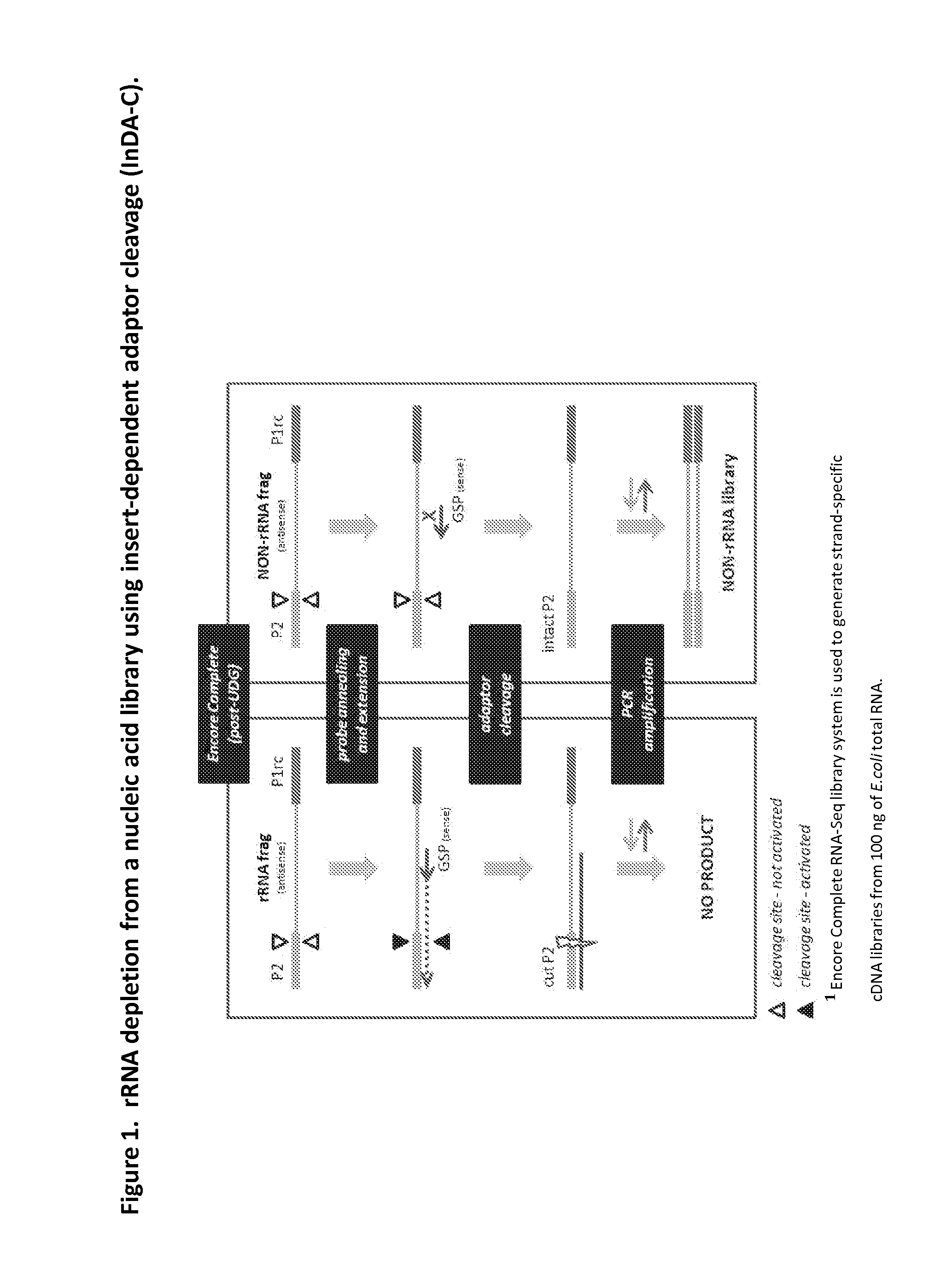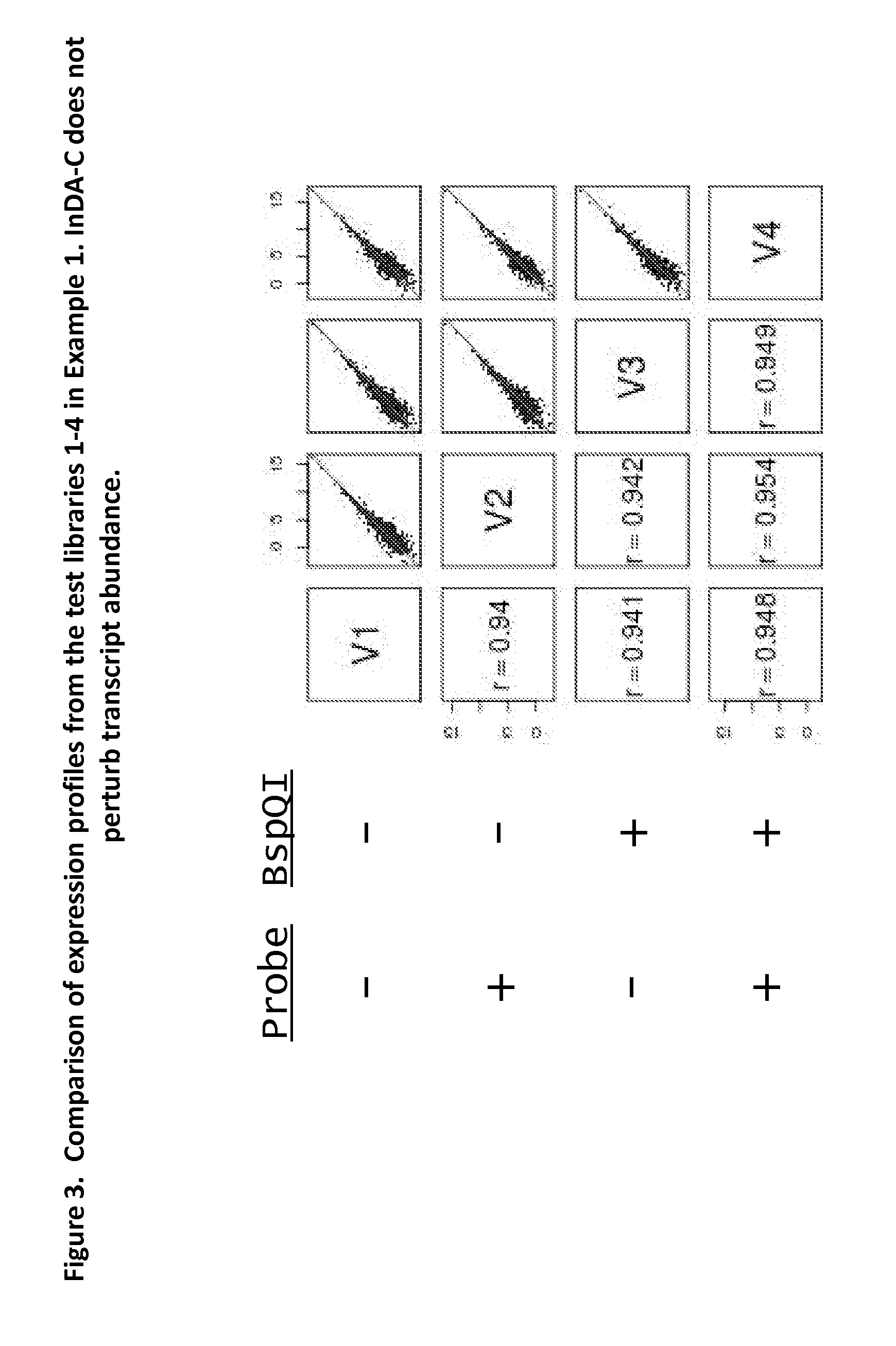Compositions and methods for negative selection of non-desired nucleic acid sequences
a nucleic acid sequence and negative selection technology, applied in the field of compositions and methods for negative selection of non-desired nucleic acid sequences, can solve the problems of inability to use prokaryotic organisms, and difficult to identify rna sequences. achieve the effect of reducing the abundance ratio
- Summary
- Abstract
- Description
- Claims
- Application Information
AI Technical Summary
Benefits of technology
Problems solved by technology
Method used
Image
Examples
example 1
Depletion of Bacterial Ribosomal RNA Fragments From Directional (i.e. Strand-Specific) Whole Transcriptome Libraries
[0195]This example describes the depletion of bacterial rRNA fragments from four directional cDNA libraries generated from E.coli total RNA, using insert-dependent adaptor cleavage (InDA-C) probes that target highly conserved prokaryotic 16S and as 23S rRNA transcript regions.
Probe Design and Synthesis
[0196]InDA-C probes that target prokaryotic rRNA transcripts were designed by comparing the ribosomal operons from a phylogenetically diverse set of 40 bacterial strains and 10 archaeal strains using the ClustalW multiple sequence alignment program (European Bioinformatics Institute). Candidate primer sequences were first selected from highly conserved sequences identified in 16S rRNA (9 sites) and 23S rRNA (7 sites) subunits. These conserved regions were computationally fragmented and analyzed by Primer3 (Steve Rozen and Helen J. Skaletsky (2000) Primer3 on the WWW for g...
example 2
Depletion of Mitochondrial DNA Fragments From a Genomic DNA Library
[0200]This example describes the depletion of mitochondrial DNA fragments from a genomic DNA library, using insert-dependent adaptor cleavage (InDA-C) probes that target the mitochondrial genome.
Probe Design and Synthesis
[0201]InDA-C probes that anneal to both strands of the hg19 version of the human mitochondrial genome sequence were selected within mitochondrial-specific segments identified by the “Duke 20 bp uniqueness” tracks provided by the UCSC Genome Browser. These sequences were then filtered for optimal predicted melting temperatures and length. Oligonucleotides ranging from 20-25 nt in length were synthesized individually and pooled in equimolar proportions. The resulting probe mix was diluted to 25 times the final concentration used in InDA-C depletion reactions (375 nM per species, 15 nM final).
Generation of Genomic DNA Libraries
[0202]The Ovation Ultralow Library System (NuGEN Technologies, San Carlos, Ca...
example 3
Generation of a Directional cDNA Library (FIG. 5)
[0204]This example describes the generation of a directional cDNA library using conventional blunt-end ligation with modified duplex adaptors and 50 ng of poly(A)+selected messenger RNA as a starting material.
First Strand Synthesis
[0205]First strand cDNA was generated using random hexamer priming. The first strand synthesis reaction was conducted using the Invitrogen SuperScript III Reverse Transcriptase kit, with 10 μM of random hexamers, 3.0 mM MgCl2 and 1.0 mM dNTPs. The cDNA synthesis reaction was carried out in 10 μL volume, incubated at 40 degrees Celsius for 60 minutes and chilled to 4 degrees Celsius.
Second Strand Synthesis With dUTP Incorporation
[0206]Second strand synthesis was performed using the New England Biolabs NEBNext Second Strand Synthesis Module, where the Second Strand Synthesis (dNTP-free) Reaction Buffer was supplemented with dNTP mix containing 0.2 mM of dATP, dCTP and dGTP, and 0.54 mM dUTP. RNAse H-mediated n...
PUM
| Property | Measurement | Unit |
|---|---|---|
| Level | aaaaa | aaaaa |
Abstract
Description
Claims
Application Information
 Login to View More
Login to View More - R&D
- Intellectual Property
- Life Sciences
- Materials
- Tech Scout
- Unparalleled Data Quality
- Higher Quality Content
- 60% Fewer Hallucinations
Browse by: Latest US Patents, China's latest patents, Technical Efficacy Thesaurus, Application Domain, Technology Topic, Popular Technical Reports.
© 2025 PatSnap. All rights reserved.Legal|Privacy policy|Modern Slavery Act Transparency Statement|Sitemap|About US| Contact US: help@patsnap.com



